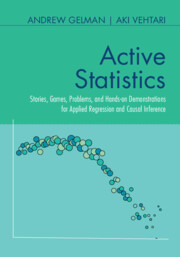 Active Statistics
Active Statistics Book contents
Chapter 2 - Setting up a course of study
from Part 1: - Organizing a plan of study
Published online by Cambridge University Press: 07 March 2024
Summary
This book provides statistics instructors and students with complete classroom material for a one- or two-semester course on applied regression and causal inference. It is built around 52 stories, 52 class-participation activities, 52 hands-on computer demonstrations, 52 drills, and 52 discussion problems that allow instructors and students to explore in a fun way the real-world complexity of the subject. The book fosters an engaging “flipped classroom” environment with a focus on visualization and understanding.
The book provides instructors with frameworks for self-study or for structuring the course, along with tips for maintaining student engagement at all levels and practice exam questions to help guide learning.
Designed to accompany the authors’ previous textbook Regression and Other Stories, its modular nature and wealth of material allow this book to be adapted to different courses and texts or to be used by learners as a hands-on workbook.
The authors are experienced researchers who have published articles in hundreds of different scientific journals in fields including statistics, computer science, policy, public health, political science, economics, sociology, and engineering. They have also published articles in the Washington Post, the New York Times, Slate, and other public venues. Their previous books include Bayesian Data Analysis, Teaching Statistics: A Bag of Tricks, and Regression and Other Stories.
- Type
- Chapter
- Information
- Active StatisticsStories, Games, Problems, and Hands-on Demonstrations for Applied Regression and Causal Inference, pp. 13 - 28Publisher: Cambridge University PressPrint publication year: 2024
